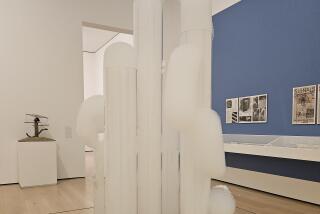In art as in music, John Cage reveals the world within
John Cage was a leading avant-garde composer for 40 years, but he also made spare watercolors, drawings and prints, plus the occasional painting, especially in the final decades of his life. Infused with the same spirit that characterizes his work as a musician, Cage’s pale color washes, Zen circles and delicate abstract markings are often lovely.
But they’re also conventional. His art doesn’t often captivate. As a visual artist Cage, whose centennial is marked this week, had fairly pronounced limitations.
Given the fact, how does one explain that his 1993 “Rolywholyover A Circus” ranks among the most memorable exhibitions organized by the Museum of Contemporary Art?
Full story | Timeline | Music | Inspiration | Events
The answer, I think, is that Cage’s marvelous show did for art what his work as a composer did for music.
Think of the exhibition as a visual concert in three movements. “Rolywholyover A Circus,” organized with Cage by former MOCA curator Julie Lazar, consisted of three head-spinning rooms of organized chaos. The spot-on title came from James Joyce’s epic comedy, “Finnegans Wake.”
The first gallery was like a domestic version of a public art museum: Household cupboards held books, records and musical scores that had been important to Cage over his creative life.
Also displayed were objects of fascination chosen from 22 museums within a 30-mile radius of MOCA — a tiny carved seed, a bustier once worn by Ingrid Bergman, a bronze sculpture. Being in the room was like rattling around inside the artist’s head.
Let’s skip Gallery 2 for a moment and go to No. 3. There, storage racks held diverse works by nearly 150 artists.
Cage had art from those racks displayed in changing patterns and random juxtapositions using a musical score based on the I Ching, the ancient Chinese system for courting knowledge through chance and random accident. Go to the museum in the afternoon, and the show looked very different than it had that same morning. Gallery attendants kept things moving all day long.
Full story | Timeline | Music | Inspiration | Events
Some art was great, some awful. Some artists were famous, some obscure. The great and the awful didn’t always match the famous and the obscure.
Nothing was labeled. You engaged objects through direct visual experience or prior knowledge. The eyes became a pathway to a messier realm of consciousness. It was like looking at stars in the night sky, pondering the immensity of creation and its mysteries. Space and time were on show.
The experience was at once humbling and thrilling — humbling because it let you feel your relative place in the vast and indifferent cosmos, and thrilling because the experience was centered not on the institutional voice of the museum as authority, but on every viewer as a privileged individual. The gallery morphed into a liberating embodiment of radical democracy.
That brings us back to room No. 2. There, the show’s ur-object was laid in a vitrine.
An autograph manuscript by Henry David Thoreau, the great 19th century transcendentalist philosopher, was open to a page featuring an unpretentious drawing of a feather. Nearby, the same feather turned up in a modest print by Cage, one of several graphics by the artist on display.
Thoreau’s book “Walden” contemplated the deep virtues of living in simplicity; his profound essay “Civil Disobedience” championed moral opposition to unjust governments. Cage, a gay man whose life was lived in a complex modern society that actively criminalized his very existence, followed Thoreau on his spiritual quest.
Full story | Timeline | Music | Inspiration | Events
Fifty-five Cage watercolors can soon be seen at the Pomona College Museum of Art, where the traveling exhibition “John Cage: Zen Ox-Herding Pictures” opens Tuesday. How does his visual aesthetic relate to his work as a composer?
Music’s central component is listening — a truth made plain by Cage’s landmark 1952 production “4’33,”” four minutes and 33 seconds of silence. Pianist David Tudor sat onstage at his instrument but did not play a single note. The room instead filled with ambient sounds, from the creaking of audience chairs to the patter of light rain on the roof.
When one is alive to the world, there is no silence. The audience, some delighted and some annoyed, perceived itself to be listening.
As listening is to music, so seeing is to visual art. Perception is a three-ring circus — lively, surprising, playful, contradictory, shaped by context, inflected by time, contemplative, generous. At MOCA, a visitor saw himself seeing.
Cage might not have made riveting art objects, but “Rolywholyover A Circus” certainly pried open a space for them. With wit and wonder, it showed that there is far more to seeing than meets the eye.
More to Read
The biggest entertainment stories
Get our big stories about Hollywood, film, television, music, arts, culture and more right in your inbox as soon as they publish.
You may occasionally receive promotional content from the Los Angeles Times.











